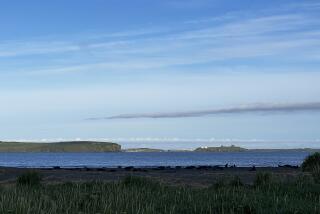Monkeys Plague Puerto Rico
TOA BAJA, Puerto Rico â When hordes of monkeys began invading Puerto Ricoâs farm fields, devastating crops, the major concern was trapping them before they reached urban areas, where they would pose a health hazard and be nearly impossible to round up.
Fear is turning to outrage. Authorities recently acknowledged that a clan of the moneys, escapees from defunct medical research laboratories on the southern coast, had turned up about 20 miles from metropolitan San Juan -- home to 1.5 million residents and countless hiding places.
âIt would be very bad if these monkeys got to San Juan,â Natural Resources Director Jose Chalbert said. His agency recently proposed capturing the wild monkeys because they carry diseases.
âI donât even want to think about having to trap monkeys there,â Chalbert said. He added that fighting in the Legislature was holding up funding for his $3-million effort to trap the monkeys.
Primates are not native to Puerto Rico. But the island has been home to one monkey species since the 1950s, when scientists brought them here for medical experiments. The animals -- descendants of the patas and rhesus monkeys that escaped from research labs -- are fertile and aggressive.
Mature monkeys can weigh 50 pounds, and the monkey population in southeast Puerto Rico is 1,000 to 2,000 -- and growing every day.
No one knows how many primates live in and around Toa Baja, a small agricultural community west of San Juan.
Toa Baja mayorâs assistant, Elias Sanchez, said that the city was trying to deal with its âvery smallâ monkey population but that trapping and control were beyond the scope of any local community.
âThe islandâs government should be helping,â he said.
Locals say dozens of monkeys have taken up residence near Toa Bajaâs dump, foraging for food and then exploring the neighborhood, frightening residents.
Emma Vasquez, who lives next to the landfill, said a baby monkey once jumped from a tree onto her roof.
âAt first we all thought it was cute,â Vasquez, 60, said. âThen it started tipping over all of my plants in the balcony, and growling at me.â
When she called police, authorities from the islandâs Department of Natural Resources showed up in white bodysuits and masks. âThat scared me even more,â she said.
The monkey eventually was sedated and removed from her roof.
Wilberto Cerrano, 55, said he had seen about 15 monkeys as close as 200 yards from his home âswinging in the trees and running around, like they are happy as can be.â
Cerrano, who lives in the Villa Clemente neighborhood, near the landfill, said he didnât think the animals would make their way into San Juan. âThey donât like people,â he said. âThey keep their distance.â
Monkeys have been traded in the Caribbean for more than 300 years, mostly for research purposes. Several islands in the region have burgeoning populations of the primates and have been trapping them and selling them for research or killing them.
Puerto Ricoâs population of wild monkeys was brought for research purposes in the 1930s. Several hundred were released on a tiny island in the Boqueron Commonwealth Forest, about a quarter-mile from Puerto Ricoâs southeast shore. Sightings of wild monkeys were first reported in the 1970s.
But it wasnât until lately that authorities discovered a new population of monkeys so close to a major city.
More to Read
Sign up for Essential California
The most important California stories and recommendations in your inbox every morning.
You may occasionally receive promotional content from the Los Angeles Times.










